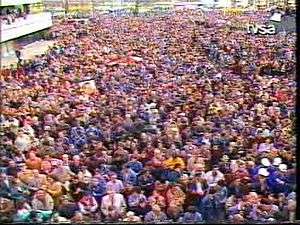1992 anti-war protests in Sarajevo
| Anti-war protests in Sarajevo | |||
|---|---|---|---|
| Part of the unrest in SR Bosnia and Herzegovina | |||
 Thousands of protesters in front of the parliament building. | |||
| Date | 5 & 6 April 1992 | ||
| Location | Sarajevo, Republic of Bosnia and Herzegovina | ||
| Caused by |
| ||
| Goals | |||
| Methods | |||
| Resulted in | Government of the SR Bosnia and Herzegovina overthrown | ||
| Parties to the civil conflict | |||
| |||
| Lead figures | |||
|
| |||
| Number | |||
| |||
| Casualties | |||
| |||
On 5 April 1992, in response to events all over Bosnia and Herzegovina 100,000 people of all nationalities turned out for a peace rally in Sarajevo. Serb snipers in the iconic Holiday Inn hotel under the control of the Serbian Democratic Party in the heart of Sarajevo opened fire on the crowd killing six people and wounding several more. Suada Dilberović and an ethnic Croat woman Olga Sučić were in the first rows, protesting on the Vrbanja bridge at the time. The bridge on which Sučić and Dilberović were killed was renamed in their honor. Six Serb snipers were arrested, but were exchanged when the Serbs threatened to kill the commandant of the Bosnian police academy who was captured the previous day, after the Serbs took over the academy and arrested him.[1][2][3]
Testimony provided by former JNA General Aleksandar Vasiljević during the Slobodan Milosevic war crimes trial in The Hague contradicts the allegation that it was Serbian snipers who opened fire. The statements provided by Vasiljević turned out later to be false.[4]
Storming of the parliament building
After the protesters had no other choice, they decided to storm into the parliament building where they founded the so-called "Narodni parliament" (People's parliament), and where they offered everybody to make a 2-minute speech on what should be done next in solving the siege problem. Many famous Sarajevans spoke to the full parliament main hall. The president of the Republic of Bosnia and Herzegovina, Alija Izetbegović also appeared and presented himself more as a citizen, rather than a president which brought loud cheering and applause. The atmosphere was at its highest point when the commander of the Special forces unit of the Ministry of Interior, Dragan Vikić appeared and told the audience: "To arm against the Serbian aggression".[5]
The spark that lit the flame
It is disputed between Bosniaks, Croats and Serbs who the first casualties of the Bosnian War are. Bosniaks and Croats consider the first casualties of the war to be Suada Dilberović and Olga Sučić.[6][7] Serbs consider Nikola Gardović, a groom's father who was killed at a Serb wedding procession on the second day of the referendum, on 1 March 1992 in Sarajevo's old town Baščaršija, to be the first victim of the war.[8]
References
- ↑ "Sarajevo, 20 years on". Retrieved 26 April 2015.
- ↑ Brendan O'Shea (January 2005). The Modern Yugoslave Conflict 1991-1995: Perception, Deception and Dishonesty. Routledge. p. 35. ISBN 978-0-415-35705-0. Retrieved 22 July 2013.
- ↑ Kemal Kurspahić (1 January 2003). Prime Time Crime: Balkan Media in War and Peace. US Institute of Peace Press. p. 99. ISBN 978-1-929223-39-8. Retrieved 22 July 2013.
- ↑ "Testimony of Aleksandar Vasiljevic, Slobodan Milosevic trial transcript,". 17 February 2003. pp. 16235/16240. Retrieved 2013-10-26.
- ↑ (In Bosnian):. "About Dragan Vikić". historija.ba. Retrieved 26 April 2015.
- ↑ "Video of the attack". radiosarajevo.ba. Retrieved 26 April 2015.
- ↑ Robert J. Donia (2006). Sarajevo: A Biography. University of Michigan Press. p. 284. ISBN 978-0-472-11557-0. Retrieved 22 July 2013.
- ↑ "International Court of Justice: Case Concerning Application of the Convention on the Prevention and Punishment of the Crime of Genocide" (PDF). Icj-cij.org. Retrieved 2013-10-26.